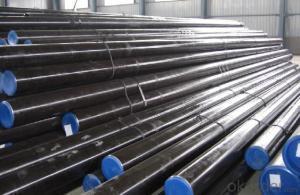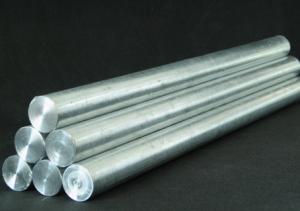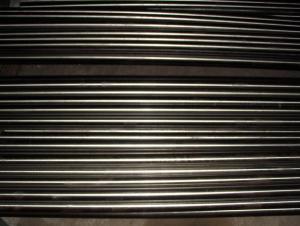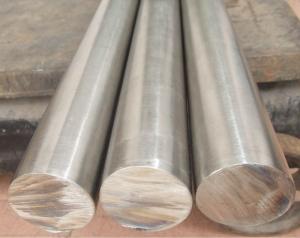316 304 stainless steel round bar polished
- Loading Port:
- Shanghai
- Payment Terms:
- TT OR LC
- Min Order Qty:
- 50 m.t
- Supply Capability:
- 2400 m.t/month
OKorder Service Pledge
OKorder Financial Service
You Might Also Like
Specification
316 304 stainless steel round bar polished
1.Product Description
Stainless Steel Bright Round Bar
Steel Rod , Steel Stick , Stainless Steel Bar, Round Steel
201, 301, 302, 303, 304, 304L, 316, 316L, 321, 309S, 309H, 310, 310S, 2205, 416, 431, 430 etc.
ASTM A276 , ASTM A484
Diameter 2mm to 400 mm or 1/8” to 15”
2 meter to 9 meter or random
Cold Drawn , Peeled , Polished , Bright , Mill Finish , Grinded
H9-H11 or K9-K11 according to ISO Dimensional Tolerance for Bar
72222000
2.Business Terms
Packing
i. Common Standard Export-sea Packing : Each bundle is fixed at lest three times strips , wrapped with durable PVC material .
ii. Special Packing : Covered with film and packed in wooden box .
MOQ:1 Ton
Payment Term:30% advanced T/T payment, the balance before shipment or against copy of B/L
Shipment Term :The goods should be loaded with 20ft container or LCL
Quality Assurance:Mill Test Certificate is provided, Third Party Inspection is acceptable , Free Sample is available for Testing and welcome to our factory for personal inspection .
3.Why Sen Po is your best choice ?
I. We have shown remarkable growth as leading manufacturer and exporter of Stainless Steel Products which are used in various industries.
II. Advantages :Our products are heavily favored for their standard material , excellent finish, optimum strength, long life, corrosion resistance , competitive price and reliable services .
III.We have exported to Ecuador, Singapore, Australia, Vietnam, Indonesia, Malaysia, Turkey, South Africa, Chile, Mexico, Brazil, Peru, Ghana, Bahrain etc. So we are rich in export experience and specialize in stainless steel .
4.Product show

5.FAQ
1.Q: How many days of your delivery?
A: The general delivery is 30~50 days according to your quantity.
2.Q: What's your main market?
A: We mainly export to Middle East and South Eastern Asia. And this year our products enter into South America.
3.Q :Are you factory?
A:Yeah, we are.
4.Q :Which countries do you export to?
A: America, India, Korea, Pakistan, Turkey, Iran and so on.
5.Q :What is the delivery time?
A: If we have stock, we can send goods within 20days. If not, we will delivery goods within 30-45days
6.Q: What is your main payment itme?
A: T/T and L/C
- Q: Can stainless steel bars be used in the medical industry?
- Yes, stainless steel bars can be used in the medical industry. Stainless steel is a popular choice for medical devices and equipment due to its excellent corrosion resistance, durability, and ease of sterilization. It is commonly used in the manufacturing of surgical instruments, orthopedic implants, dental tools, and various other medical equipment. Stainless steel bars are often utilized in the construction of these products, as they can be easily shaped, machined, and welded to create complex designs. Additionally, stainless steel is biocompatible, meaning it can safely interact with biological tissues without causing adverse reactions. This makes stainless steel bars a reliable and versatile material for use in the medical industry.
- Q: How do you clean and maintain stainless steel bars?
- To clean and maintain stainless steel bars, you can follow these steps: 1. Start by removing any loose dirt or debris from the surface of the bars using a soft cloth or a brush. This will help prevent scratching during the cleaning process. 2. Prepare a cleaning solution by mixing warm water with a mild detergent or dish soap. Avoid using abrasive cleaners or harsh chemicals as they can damage the stainless steel finish. 3. Dip a soft cloth or sponge into the cleaning solution and gently scrub the stainless steel bars in the direction of the grain. This will help prevent scratching and maintain the appearance of the bars. 4. Pay special attention to any stubborn stains or marks. You can use a non-abrasive scrubbing pad or a soft-bristle brush to gently remove these without causing any damage. 5. Rinse the bars thoroughly with clean water to remove any soap residue. Ensure all cleaning solution is completely removed from the surface. 6. Dry the stainless steel bars with a soft, clean cloth to prevent water spots or streaks. Make sure the bars are completely dry before proceeding to the next step. 7. To maintain the shine and protect the stainless steel, you can apply a stainless steel cleaner or polish. Follow the manufacturer's instructions on the product and apply it using a clean cloth or sponge, rubbing in the direction of the grain. 8. Wipe off any excess cleaner or polish with a separate clean cloth, again following the grain of the stainless steel. 9. For regular maintenance, you can simply wipe down the stainless steel bars with a damp cloth or sponge to remove any surface dust or fingerprints. 10. Avoid using abrasive materials, steel wool, or harsh chemicals on stainless steel bars as they can scratch or damage the surface. By following these steps, you can effectively clean and maintain the appearance of your stainless steel bars, keeping them looking shiny and pristine for years to come.
- Q: Are stainless steel bars suitable for manufacturing valves?
- Yes, stainless steel bars are suitable for manufacturing valves. Stainless steel offers excellent corrosion resistance, durability, and strength, making it a preferred material for valve production. It can withstand high temperatures, pressure, and harsh environments commonly found in industrial applications. Additionally, stainless steel's hygienic properties make it ideal for use in the food and beverage, pharmaceutical, and chemical industries.
- Q: Can stainless steel bars be used in the oil refining manufacturing industry?
- Indeed, the oil refining manufacturing industry can utilize stainless steel bars. Stainless steel, a flexible and corrosion-resistant material, is widely employed in numerous sectors, including oil refining. Given the corrosive and high-temperature substances involved in the oil refining process, stainless steel bars are well-matched for such conditions. Stainless steel bars possess remarkable corrosion resistance, ensuring their ability to endure the harsh chemicals and corrosive atmospheres present in oil refineries. Additionally, they can maintain their structural integrity even at elevated temperatures, rendering them suitable for manufacturing equipment and components required in the oil refining process. Moreover, stainless steel bars boast excellent mechanical properties, such as high strength and durability, which are imperative for ensuring the dependability and longevity of equipment within the oil refining industry. Their ability to be easily fabricated and machined into various shapes and sizes further allows for customization to meet specific requirements. To summarize, stainless steel bars are highly appropriate for utilization in the oil refining manufacturing industry due to their corrosion resistance, high-temperature resistance, and outstanding mechanical properties. Their capacity to withstand harsh environments and their versatility make them an ideal choice for diverse applications in the oil refining process.
- Q: What is the difference between seamless and welded stainless steel bars?
- The main difference between seamless and welded stainless steel bars lies in the manufacturing process and the resulting characteristics of the finished product. Seamless stainless steel bars are made by piercing a solid billet or ingot, then rolling it into a thin-walled tube. This tube is then elongated and stretched to the desired length and thickness. The seamless process eliminates the need for welding, resulting in a product that has no longitudinal or transverse seams. This seamless construction offers several advantages, such as enhanced corrosion resistance, improved strength, and a smoother surface finish. Seamless stainless steel bars are often used in applications where high pressure and extreme temperatures are encountered, such as in the oil and gas industry or for critical components in chemical processing plants. On the other hand, welded stainless steel bars are manufactured by forming flat strips or plates into a cylindrical shape, then welding the edges together to create a continuous bar. The welding process can be done by various methods, such as TIG (tungsten inert gas) or MIG (metal inert gas) welding. Welded stainless steel bars are generally more cost-effective and readily available compared to seamless bars. However, they may have a slightly lower strength and corrosion resistance due to the presence of the weld seam. Welded stainless steel bars are commonly used in less demanding applications, such as architectural designs, decorative purposes, or general fabrication. In summary, the key differences between seamless and welded stainless steel bars lie in the manufacturing process, resulting characteristics, and intended applications. Seamless bars offer superior strength, corrosion resistance, and smooth surface finish, making them suitable for high-pressure, high-temperature environments. Welded bars, on the other hand, are more cost-effective and readily available, making them suitable for less demanding applications where strength and corrosion resistance are not critical factors.
- Q: What are the different surface treatments available for stainless steel bars?
- There are several different surface treatments available for stainless steel bars, each offering unique benefits and characteristics. 1. Pickling: This process involves the use of an acid solution to remove impurities and oxide scale from the surface of the stainless steel bars. It leaves the bars with a clean and smooth surface, enhancing corrosion resistance and improving aesthetics. 2. Passivation: Passivation is a chemical treatment that removes iron particles and other contaminants from the surface of stainless steel bars. This treatment forms a protective oxide layer, reducing the risk of corrosion and improving the overall lifespan of the bars. 3. Electropolishing: Electropolishing is an electrochemical process that removes a thin layer of metal from the surface of stainless steel bars. This treatment results in a smooth, shiny, and clean surface, while also enhancing corrosion resistance and making the bars easier to clean. 4. Shot blasting: Shot blasting involves bombarding the surface of stainless steel bars with small metal or glass beads at high velocity. This process removes contaminants, scale, and impurities, leaving the bars with a textured surface. Shot blasting is commonly used to prepare the bars for subsequent coating or painting. 5. Grinding: Grinding is a mechanical process that involves using abrasive wheels or belts to remove surface imperfections and create a smooth finish on stainless steel bars. This treatment is often used to improve the appearance and prepare the bars for further processing or finishing. 6. Brushing: Brushing is a surface treatment that involves using abrasive belts or brushes to create a brushed or satin finish on stainless steel bars. This treatment leaves visible parallel lines on the surface, giving the bars an elegant and aesthetically pleasing look. 7. Coating: Coating stainless steel bars can provide additional protection against corrosion and enhance their appearance. Common coating options include powder coating, electroplating, and PVD (Physical Vapor Deposition) coating. These coatings can offer different colors, textures, and levels of corrosion resistance. It is important to choose the appropriate surface treatment for stainless steel bars based on the intended application, desired appearance, and required level of corrosion resistance. Consulting with a professional or supplier who specializes in stainless steel surface treatments can provide further guidance and ensure the best results.
- Q: Can stainless steel bars be polished?
- Yes, stainless steel bars can be polished. Polishing stainless steel bars enhances their appearance by creating a smooth, glossy, and reflective surface.
- Q: What are the different surface finishing methods for stainless steel bars?
- For stainless steel bars, there are numerous options available when it comes to surface finishing methods, each with its own distinct advantages and aesthetic qualities. Some of the most commonly used methods are as follows: 1. Mill Finish: This is the standard finish that is achieved right after the manufacturing process. It is characterized by a smooth and untouched surface. Mill finish is typically used in applications where appearance is not a top priority. 2. Brushed Finish: Also referred to as a satin finish, this method involves brushing the surface with abrasive materials to create a consistent and directional grain pattern. It offers a clean and contemporary appearance while effectively concealing minor scratches and fingerprints. 3. Mirror Finish: By employing a process of polishing and buffing, this method results in an incredibly smooth and highly reflective surface. It is often utilized in decorative applications where a luxurious and visually appealing finish is desired. 4. Bead Blast Finish: This technique entails blasting tiny glass beads onto the stainless steel bar's surface, resulting in a uniform matte texture. It provides a non-reflective and consistent appearance, making it ideal for applications where reducing glare is important. 5. Passivation: This is a chemical process that eliminates impurities and enhances the corrosion resistance of stainless steel bars. It involves immersing the bars in a solution containing nitric or citric acid, which helps eliminate surface contaminants and restore the passive film. 6. Electroplating: This method involves depositing a layer of metal, such as chrome or nickel, onto the surface of the stainless steel bar. It not only enhances the appearance but also provides additional protection against corrosion. 7. PVD Coating: Physical Vapor Deposition (PVD) is a technique that involves depositing a thin layer of metal onto the stainless steel surface using a vacuum chamber. This method allows for a wide variety of colors and finishes, including gold, bronze, and black, providing both visual appeal and durability. Each of these surface finishing methods offers unique visual effects, levels of protection, and durability, making it possible for stainless steel bars to meet a wide range of functional and aesthetic requirements. The choice of finishing method depends on the specific application, end-use, and desired appearance.
- Q: Are stainless steel bars suitable for manufacturing tools?
- Yes, stainless steel bars are suitable for manufacturing tools. Stainless steel is a versatile and durable material that offers several advantages for tool production. Firstly, stainless steel has excellent corrosion resistance, making it suitable for tools that may be exposed to moisture or chemicals. This corrosion resistance ensures that the tools will not rust or deteriorate over time, increasing their lifespan. Additionally, stainless steel has high strength and hardness, making it ideal for creating tools that need to withstand heavy usage and provide consistent performance. Stainless steel also offers good heat resistance, allowing the tools to maintain their shape and properties even at high temperatures. Furthermore, stainless steel can be easily machined and fabricated, enabling the production of complex and intricate tool designs. Overall, stainless steel bars provide the necessary properties and characteristics required for manufacturing high-quality and long-lasting tools.
- Q: What are the maximum load capacities of stainless steel bars?
- The maximum load capacities of stainless steel bars vary depending on various factors such as the grade of stainless steel, the size and shape of the bar, and the specific application. It is recommended to consult engineering specifications, industry standards, or manufacturers' guidelines to determine the maximum load capacities for a specific stainless steel bar.
Send your message to us
316 304 stainless steel round bar polished
- Loading Port:
- Shanghai
- Payment Terms:
- TT OR LC
- Min Order Qty:
- 50 m.t
- Supply Capability:
- 2400 m.t/month
OKorder Service Pledge
OKorder Financial Service
Similar products
Hot products
Hot Searches
Related keywords

























